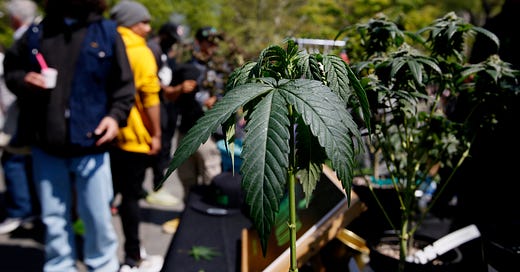TL(PM) DIGEST: Seems like every path leads to nowhere
Plus a weeklong ceasefire in Sudan, a half-baked approach to marijuana legalization in New York, and China's youth unemployment crisis

1. Only one fifth of Americans believe the country is headed in the right direction
What happened? New polling from AP/NORC finds Americans deeply pessimistic about the direction of the country and the nation’s economy. Only 21 percent of U.S. adults feel that the country his headed in the right direction while roughly one-quarter feel that the economy is in good shape.
Why does it matter? As the nation edges closer to a historic default on its contractual debt obligations, Americans across party lines are clearly not happy with the state of the nation—and by extension, the nation’s political leaders who are responsible for running things.
TLP’s take: National politics is a dysfunctional mess to most Americans, and no amount of spinning by either the president or the Republicans in Congress will improve matters—only results. Defaulting on our nation’s debt will send the country into an economic tailspin and while Republicans have clearly exploited the situation to their benefit, President Biden faces limited choices now and must lead the country to some resolution this week or risk taking the bulk of the blame as the nation’s leader.
2. Week-long ceasefire agreed to in Sudan
What happened? Two weeks of talks between Sudan’s two main armed factions—the Sudanese military and the paramilitary Rapid Support Forces—in Jeddah have yielded an agreement for a week-long ceasefire, Saudi and American officials announced over the weekend. A monitoring committee comprised of members of the two factions as well as Saudi and American representatives will oversee the deal.
Why does it matter? Previous attempts by the United States and other foreign governments to broker temporary ceasefires in Sudan have failed, and it remains to be seen whether this Saudi-led initiative will have more success. But any serious diplomatic effort to at least temporarily bring the fighting in Sudan to a halt and alleviate civilian suffering—850 civilians have been killed and roughly 60 hospitals have been shuttered since violence broke out in mid-April—deserves a chance to work.
TLP’s take: Hopefully joint U.S.-Saudi diplomacy will succeed where previous efforts have failed and bring at least a modicum of temporary relief to ordinary Sudanese caught in the crossfire of their country’s violent power struggle. If it does, it’ll show that, for all its problems, the U.S.-Saudi strategic partnership remains an important and potentially constructive factor in global politics.
3. A half-baked approach to weed legalization in New York
What happened? The New York Times reports on the widespread use of motor vehicles by people under the influence of marijuana. Few arrests have been made despite “driving while stoned” being illegal like drunk driving.
Why does it matter? Recreational marijuana use was legalized statewide in New York in 2021 but the ability of the state to control the consequences of this action seems remote. As the NYT highlights:
…arrests are scant in New York, a city of 8.5 million residents with more than two million cars and 36,000 police officers. Police officials said they arrested 204 people last year for driving under the influence of drugs, and at least 83 so far this year. It is unclear how many arrests were for marijuana, because police officials do not break down arrests by type of substance. By comparison, there were 3,291 arrests last year for drinking and driving.
TLP’s take: It’s perfectly reasonable and democratic to legalize recreational use of marijuana if that’s what a state’s citizens want—but it’s totally unreasonable and unsafe to have no public boundaries whatsoever for pot. People can’t just walk around wasted and drinking alcohol in public in most places—or worse, drive under the influence—and states like New York that have legalized pot will need to reconsider their approach given irresponsible and antisocial behavior among a number of marijuana users.
4. China’s youth unemployment crisis
What happened? Beijing reported a youth unemployment rate of 20.4 percent last week, meaning that over a fifth of Chinese citizens aged 16 to 24 did not have jobs in the most recent statistical reporting period. Some twelve million young people will enter the Chinese job market next month alone, and almost 2.5 million of them will not find employment.
Why does it matter? This statistic shows that China’s economy isn’t bouncing back the way many believed it might once Beijing lifted its “zero COVID” policies at the end of last year. It’s also an indication that China’s economic future may not be as bright as many predict, both in the near and long terms.
TLP’s take: Large pools of unemployed young people—especially unemployed young men—are never good for social and political stability at home. It’s another factor for the United States and its allies to keep an eye on as they respond to the geopolitical challenge posed by the ruling Chinese Communist Party, one that exposes severe flaws in Beijing’s repressive political and economic model.
Just one more thing…
Using laser detection and ranging technology to peer through dense Central American jungles, archaeologists have discovered more than 400 ancient Mayan cities linked by some 117 miles of roads—revealing a far more complex civilization that predated the construction of better-known cities and monuments like the pyramid of Chichen Itza.







